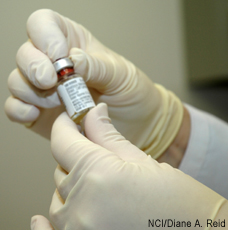 |
 |
 |
Other Health Topics:

-
Related Topics
-
Go Local
- Services and providers for Smallpox in the U.S.
-
National Institutes of Health
- The primary NIH organization for research on Smallpox is the National Institute of Allergy and Infectious Diseases
Languages
- Khmer (Khmer)
- Russian (Русский)
- Somali (af Soomaali)
- Spanish (español)
- Vietnamese (Tiếng Việt)
Smallpox is a disease caused by the Variola major virus. Some experts say that over the centuries it has killed more people than all other infectious diseases combined. Worldwide immunization stopped the spread of smallpox three decades ago. The last case was reported in 1977. Two research labs still house small amounts of the virus. Experts fear bioterrorists could use the virus to spread disease.
Smallpox spreads very easily from person to person. Symptoms are flu-like and include high fever, fatigue and headache and backache, followed by a rash with flat red sores.
The U.S. stopped routine smallpox vaccinations in 1972. Military and other high-risk groups continue to get the vaccine. The U.S. has increased its supply of the vaccine in recent years. The vaccine makes some people sick, so doctors save it for those at highest risk of disease.
National Institute of Allergy and Infectious Diseases
-
Smallpox
 (Patient Education Institute) - Requires Flash Player
(Patient Education Institute) - Requires Flash Player
Also available in Spanish
-
Smallpox
 (National Institute of Allergy and Infectious Diseases)
(National Institute of Allergy and Infectious Diseases)
-
What You Should Know about a Smallpox Outbreak(Centers for Disease Control and Prevention)
Also available in Spanish
| Basics | Learn More | Multimedia & Cool Tools |
|---|---|---|
| Research | Reference Shelf | For You |
-
Overviews
- Smallpox(Mayo Foundation for Medical Education and Research)
-
Smallpox Disease Overview(Centers for Disease Control and Prevention)
Also available in Spanish
-
Prevention/Screening
- FDA Approves Second-Generation Smallpox Vaccine(Food and Drug Administration)
- List of Medications Contraindicating Receipt of Smallpox Vaccine(Centers for Disease Control and Prevention)
- Live Virus Smallpox Vaccine(Centers for Disease Control and Prevention)
- Side Effects of Smallpox Vaccination(Centers for Disease Control and Prevention)
-
Smallpox Vaccine and Heart Problems: Information for People Who Have Recently Received the Smallpox Vaccine(Centers for Disease Control and Prevention)
Also available in Spanish
-
Smallpox Vaccine Overview(Centers for Disease Control and Prevention)
Also available in Spanish
- Smallpox Vaccine: What You Should Know(American Academy of Family Physicians)
-
What to Do After You’ve Gotten the Smallpox Vaccine(Centers for Disease Control and Prevention)
Also available in Spanish
-
Related Issues
- Frequently Asked Questions about Smallpox(Centers for Disease Control and Prevention)
- Smallpox Vaccine and Atopic Dermatitis/Eczema(National Eczema Association for Science and Education)
- Smallpox Vaccine and Cancer(American Cancer Society)
- What We Learn about Smallpox from Movies - Fact or Fiction(Centers for Disease Control and Prevention)
-
Pictures & Photographs
-
 Smallpox (Variola)(Logical Images)
Smallpox (Variola)(Logical Images)
- Smallpox Disease Images(Centers for Disease Control and Prevention)
- Vaccine Reaction Images(Centers for Disease Control and Prevention)
-
- Tutorials Return to top
-
Clinical Trials
-
ClinicalTrials.gov: Smallpox
 (National Institutes of Health)
(National Institutes of Health)
-
ClinicalTrials.gov: Smallpox
-
Journal Articles
References and abstracts from MEDLINE/PubMed (National Library of Medicine)
- Article: Evaluation of preterm births and birth defects in liveborn infants...
- Article: A relationship between US healthcare worker smallpox vaccination rates in...
- Article: An extremely diverse CD4 response to vaccinia virus in humans...
- Smallpox -- see more articles
-
Organizations
-
Centers for Disease Control and Prevention
Also available in Spanish
-
National Institute of Allergy and Infectious Diseases

- World Health Organization
-
Centers for Disease Control and Prevention
-
Law and Policy
- Smallpox Vaccine Injury Compensation Program(Health Resources and Services Administration)
- What CDC Is Doing to Protect the Public From Smallpox(Centers for Disease Control and Prevention)
-
Children
- What Is Smallpox?(Nemours Foundation)
-
Teenagers
- Smallpox(Nemours Foundation)
-
Women
- Smallpox Vaccination Information for Women Who Are Pregnant or Breastfeeding(Centers for Disease Control and Prevention)
| Home | Health Topics | Drugs & Supplements | Encyclopedia | Dictionary | News | Directories | Other Resources | |
| Copyright | Privacy | Accessibility | Quality Guidelines U.S. National Library of Medicine, 8600 Rockville Pike, Bethesda, MD 20894 National Institutes of Health | Department of Health & Human Services |
Date last updated: 10 September 2008 Topic last reviewed: 20 July 2008 |






